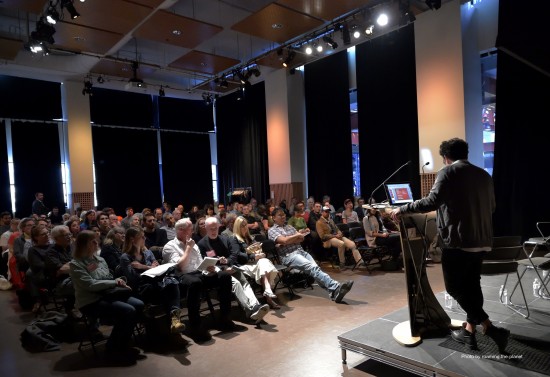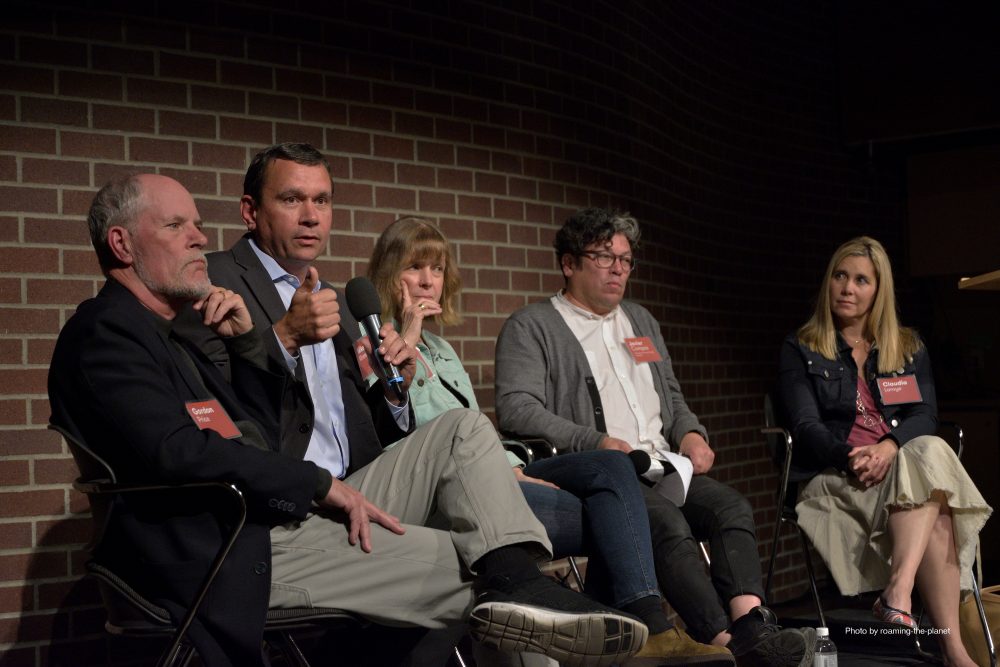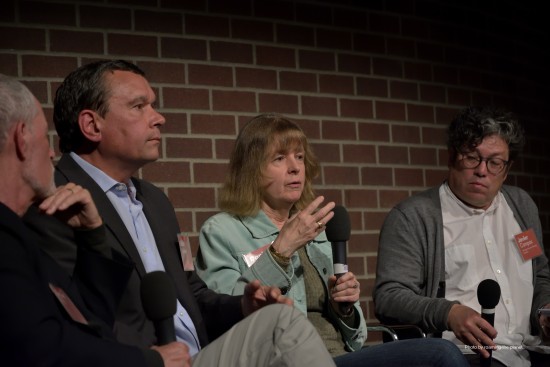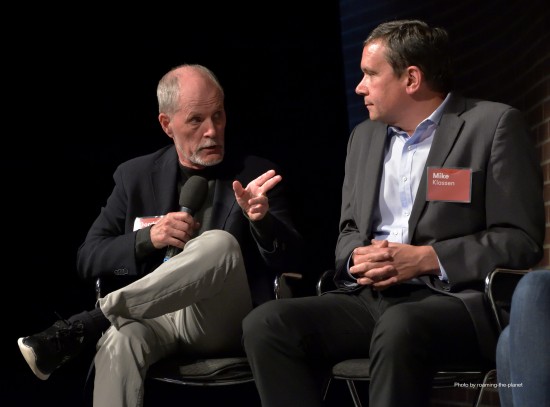Shaping Vancouver 2016: Conversation 3
What Do I Want From My Street? – Change Is Coming To Cambie, Main, Fraser
The third talk of Shaping Vancouver 2016 – What do I want from my street? Change is coming to Cambie, Main, Fraser – discussed with the impact of Transit Oriented Development along some of Vancouver’s prominent North South arterial streets, Cambie, Main, Fraser. These neighbourhood’s character and street level retail have been impacted by the development of high-density mixed-use areas close to public transport. While this development does increase a highly needed housing supply, questions around diversity, density, distribution, community assets and the neighbourhood quality have been raised. These developments may allow low-density single unit dwellings to persist, but this discussion aimed to analyze how this type of development will influence Vancouver communities.
Moderator
Javier Campos
President of Heritage Vancouver Society, The Contemporary Art Gallery Board Member.
Panelists
Danielle Peacock
Resident of Mount Pleasant for over 35 years and a long term resident of the Quebec Manor Housing Co-op.
Gordon Price
Director of the City Program at Simon Fraser University, served as City Councilor in Vancouver, was a member of the Board of the Greater Vancouver Regional District and appointed to the first board of the Greater Vancouver Transportation Authority.
Claudia Laroye
Executive Director of the Marpole Business Association, co-chair of the Fair Tax Coalition and has served on the Executive of the Business Improvement Associations of BC.
Mike Klassen
Senior strategic communications and public affairs professional who works with stakeholders in government and the non-profit and private sectors and active member of his Fraser street neighbourhood.

Moderator Javier Campos began discussion by asking the panelists how the arterial streets of Cambie, Main and Fraser contribute to the surrounding community. Panelists shared their experiences in this neighbourhood and highlighted that the businesses along these streets provided walkable access to their daily needs, offered employment and provided taxation benefits to the neighbourhood. The panelists emphasized that the interconnected community atmosphere of this neighbourhood is what makes it such a valuable place.
The discussion and question period demonstrated the frustration residents feel towards the implementation of high density developments in Vancouver. Residents fear the character of their neighbourhoods are rapidly changing without community input and that these developments will push long-term residents out of the area. The discussion among the panelists focused on the rate of change in these areas, how land usage could influence development and the importance of community initiative in the face of crisis.

Rate of Change
Javier Campos asked the panelists for their thoughts on the accelerated rate of change occurring in the neighbourhoods surrounding Cambie, Main and Fraser. Danielle Peacock voiced her concerns about how high level development could negatively impact the small businesses that are in these neighbourhoods. She commented that the Main Street area is becoming increasingly independent as a community, where streets feel alive with people that support the local, diverse, and vibrant businesses. She made reference to Quebec Manor, a housing co-op that is within a heritage building, suggesting that strong roots in community inclusiveness make it more sustainable than the new developments proposed. Gordon Price offered finding an appropriate rate of change in a neighbourhood is a challenging task, as community members feel anxious with slow rate of change also. Price suggested that community members need to accept that anxiety in regards to the pace of neighbourhood development will not completely disappear. Mike Klassen discussed how developments could bring community to the Fraser area but also warned of what new developments could do to existing communities, as it could lead to gentrified areas. Price retorted that this is the classic dilemma of gentrification; as areas become more successful they become highly sought after and then expensive. Peacock posed the possibility of applying zoning policy that would ensure 7th-11th avenue remain small scale developments, which she believed would make development move at a more reasonable pace. In response to this suggestion, Price noted that this would only increase rental prices and freezing the development of a neighbourhood would only harm its vitality.


Land Usage
Panelists stressed the importance of maintaining spaces for small businesses within these communities. Peacock voiced her concerns that small businesses would be driven out of the Cambie, Main and Fraser neighbourhoods when large scale developments begin to establish themselves. She suggested that restricting storefront sizes in these areas may deter large businesses, allowing smaller businesses to remain. Price responded that this strategy has been attempted before in Vancouver and resulted in more creative storefronts but it did not stop large businesses outright. Campos asked the panelists where small businesses could be relocated and if it would be possible for small businesses to weave themselves into residential areas. Klassen strongly agreed with this idea, suggesting high density residential buildings that incorporate commercial space on the ground level is a suitable option. He added that the low number of historically significant buildings and architecture in this area would allow for developers to imagine and create new buildings with this integration in mind. Klassen further stated that this model has been effective in the Fraser area, citing the integration of coffee shops JJBean and Prado into their surrounding community. Price warned against the idea of building mass numbers of new developments, as all new buildings would result in a loss of character to the neighbourhood regardless of heritage designation. Price responded to Campos question of integrating commercial space into residential areas by stating that in order to keep the character of a building and neighbourhood you must keep the same people. Campos responded accepting and responding to the inevitability of change allows us to analyze the intangible contributions a building makes to a neighbourhood, such as increasing walkability.

Importance of Community Initiative
Panelists reflected on the initiative taken on by community members when establishing the Cambie, Main and Fraser neighbourhoods. Several mentioned the efforts to clean up community spaces as well as celebrate the history of these neighbourhoods. Claudia Laroye mentioned the importance of crisis in regard to community development. She stated that crisis commonly spurs action from community members, which leads to effective change. Panelists agreed on the importance of a symbiotic relationship between community members and local businesses; ensuring that the businesses serve the public need and that the community embraces and supports the business. Peacock stated again that property value increases that come along with high density development will harm the success of small businesses as they can not afford to remain there. Laroye agreed and noted that currently community members are unable to influence or advise on what a landowner may choose to develop, which can result in a development less suitable for the community. Several panelists emphasized the hope they have in the community members to rally for their neighbourhoods in the Cambie, Main and Fraser area.
Questions from the audience
Conversation has been focused on businesses and housing but what about recreational and cultural space? Don’t you think these contribute to community? Why are we not developing these spaces into our communities?
Panelists all agreed that cultural and recreational spaces are needed and wanted within communities. Gordon Price reminded the audience however that in order to fund these spaces, residents would need to pay more in taxes, which many are resistant to. The audience member suggested that the city seemed to have ample money when it came to installing bike lanes, to which Price responded that pining issues against each other makes any real progress difficult, and the simple response is that it is not realistic to expect these cultural and recreational spaces while maintaining low taxation. Mike Klassen mentioned that many of these facilities are receiving funding through rezoning taxation on new developments.
It seems at the the issue is a question of who are these new businesses for? The residents? Or are they high-end boutiques made to draw shoppers and visitors to the neighbourhood? Where do you draw the line, in terms of who the neighbourhood is actually serving?
Panelists noted that this has happened in many neighbourhoods that have gone through gentrification and high density development. Often high-end retail stores are developed that do not serve the immediate communities needs. Gordon offered that if development does not happen, buildings will sit idle or decay, which also harms the neighbourhood.
For Claudia: Has the development on 70th and Granville had a positive or negative impact on businesses and community?
Claudia responded that the development has overall has a positive impact. She noted that the construction period was difficult, as it made the area hard to access and navigate however it now seems to be working well for businesses and residents. Gordon asked Claudia what difference did businesses experience with the introduction of the Canada Line and the cancellation of the BLine. Claudia responded that businesses have appreciated the extra parking that was made possible but noted that many residents miss the BLine, as it offered them a quick way to downtown Vancouver.
Some cities allocate money for residents who do not have the monetary means to make needed repairs on heritage buildings, does this happen to in Vancouver? Do residents have access to this funding?
Gordon assured the audience that this funding does exist in Vancouver and is available to residents.
Is there any way to encourage people to work and live within the same community? This would establish community and engage people in their neighbourhoods, which could make neighbourhood businesses better reflect the people that actually live there.
Claudia noted that single unit dwellings and three storey walk ups are currently the predominant types of housing in this area, which are not feasible to many demographics. She reiterated the need for more housing options that would incorporate gentle densification as well as encourage neighbourhood interaction. Mike stated that this would simply push the issue of development into another neighbourhood. Claudia responded to Mike’s comment that the main arterial streets are being asked to accommodate a higher density than was originally discussed. Danielle suggested that residents of these neighbourhoods are becoming more accepting of these changes and trying to work with development proposals. Gordon reminded the audience of the importance of attending developments meetings, stating that many people discuss community issues and offer ideas with other residents however city meetings are poorly attended. Mike suggested that residents need to communicate and utilize the anger they feel towards these developments to make effective change.
Should we be questioning the paradigm of arterial streets? Businesses and developments rely on these streets and developments try to use the space to its maximum capacity, creating a ‘make or break’ atmosphere in a neighbourhood. Do you believe we could see a resurgence of micro-economies within residential neighbourhoods? Currently businesses run out of laneways are often operating illegally and under the table, meaning they do not pay taxes that could be going back to the community. Should the city be legalizing these businesses?
Gordon stated that he would like to see community signatures gathered to support this idea. He stressed that it is the responsibility of communities to bring these ideas and their support forward. He mentioned that it would be unlikely for the city to legalize illegal businesses without the demonstrated support of the residents that live there.
All of the streets we like to walk down have a history, and we are often simply trying to take a snapshot of a community and keep everything the same. A community's history is more like a movie that changes over time and is going to be different from other neighbourhoods. We need to accept that one method for a great streetscape will not work for all neighbourhoods, or we would have resolved this long ago. Will community engagement swing like a pendulum leading to no involvement?
Mike responded that there is no immediate answer to this question, but stated that in his experience the residents of this city have always seemed to step up for involvement when it’s needed. Gordon offered that residents will argue throughout development but often warm up to the developments in the years after its completion as it becomes part of the community. He questioned the pressure we currently put on arterial streets to become traffic sewers to get people through the city quickly. He suggested that if we don’t begin to address this issue then issues over community will be irrelevant.
Question for Gordon, how should we be developing? How are we able to proceed?
Gordon responded that there are three options: don’t come here, leave or be open to crowding. He stated community residents need to be honest and critical about the opportunity that is available in Vancouver, as the city is unable to provide for everyone. He continued saying that residents will also have to realistically evaluate their needs and determine if it makes sense to live within Vancouver. Lastly, he suggested that citizens of Vancouver need to accept that higher density is needed, which will require them to show flexibility within their neighbourhoods.
We acknowledge the financial assistance of the Province of British Columbia. Thank you to SFU’s Vancity Office of Community Engagement for co-presenting the series.
All photo credits go to roaming-the-planet.